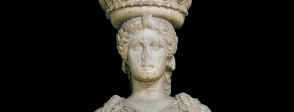Look at the photo of the karyatid in For the classroom. Discuss whether she seems to be standing in a relaxed way, whether she seems rich or poor, what she has on her head and what position the students think her arms were in. Then look at the drawing of the Erechtheion by Webb and identify what her role is on the building. Discuss what effect her relaxed pose has and why the architect did not show her straining under the weight. Look at the Ionic column from the Erechtheion and consider how the dress of the karyatid echoes the flutes or grooves on the column.
Compare the capital (top) of the column from the Erechtheion with the capital of the column from the Parthenon in For the classroom. From here you can move easily into identifying the features of the Doric and Ionic orders of architecture – there is a diagram in the link in For the classroom. Once the students are familiar with the two main orders, introduce the Corinthian order, which was not used widely by the Greeks, but was very popular with the Romans. Armed with this knowledge the students are ready to identify the orders on a walk round their town or on photos of classical buildings from ancient and more recent times – there are hundreds of these to download form the internet.
Learn the names of the architectural elements of a temple: columns, Doric and Ionic friezes, triglyphs and metopes, pediments, akroteria. Find out how they were decorated and carry out an internet search to find different examples of metopes, friezes and pediments – there are some starters in For the classroom. Discuss how the temples were painted.
Play the temple-building game in For the classroom. To increase the complexity of the game and to introduce some maths, allocate each aspect of the temple a cost. Give groups of students different budgets and ask them to build the best temple they can from that budget. You could find out the names of different Greek cities around the Mediterranean and identify each group with a city.
Look at the ground plans of a selection of temples to see how they were laid out. Think about how each area was used: where the statue of the god stood, where the offerings and treasures were kept, where the people could walk and visit. Remind students that large-scale worship took place outside at the altar.
Use links in For the classroom to introduce other buildings on the acropolis in Athens and the festivals to the gods. Introduce different sorts of ancient Greek buildings such as the theatres at Epidauros and Ephesos, the stadiums at Delphi and Olympia. Students could choose a building and create a presentation or display: where was the building, what was it used for, which god was it connected with, how was it designed for its purpose, what has survived and what has been lost?
Look at the buildings in A bigger picture. Ask the students to identify the order of the architecture. Do some map work to identify the locations of the ancient buildings. The students should realise that there were Greek buildings outside Greece itself. Do some further research to add other Greek temples to your map. Why were there Greek temples all over the Mediterranean area? Find out about Greek colonisation in the 700s and 600s BC. Choose a few cities outside Greece and find out more about them.
Use Object file: a Greek goddess to find out more about Greek religion and what happened at festivals and sacrifices.
Look at the photos of St Pancras’ Church in For the classroom and identify how it has used the Erechtheion as a model. Other parts of the church such as the patterns on the columns and around the doors are also derived from the Erechtheion. Compare the photo of the British Museum in For the classroom. Why have these two different buildings used Greek styles? What effect do the students think it has on the visitor? Carry out a survey of your area looking for classical architecture and consider why each building has been designed that way. Compare other architectural styles using images form the internet or near the school.
Look at the drawings in A bigger picture. How have these Greek buildings been shown? Why do people find ruins romantic? What effect do the students think it has to include local people in the pictures?
The karyatid is a human version of an inanimate column. Look at the nautilus shell cup in For the classroom and discuss how the different parts have been shown. How is each animal part suited to its function? Discuss how we give the names of parts of the body to parts of objects: foot, lip, mouth, neck. Look at other examples of the use of human or animal forms on buildings or for pieces of furniture or vessels. Students could design their own teapot, for example, using different animals for different parts.


